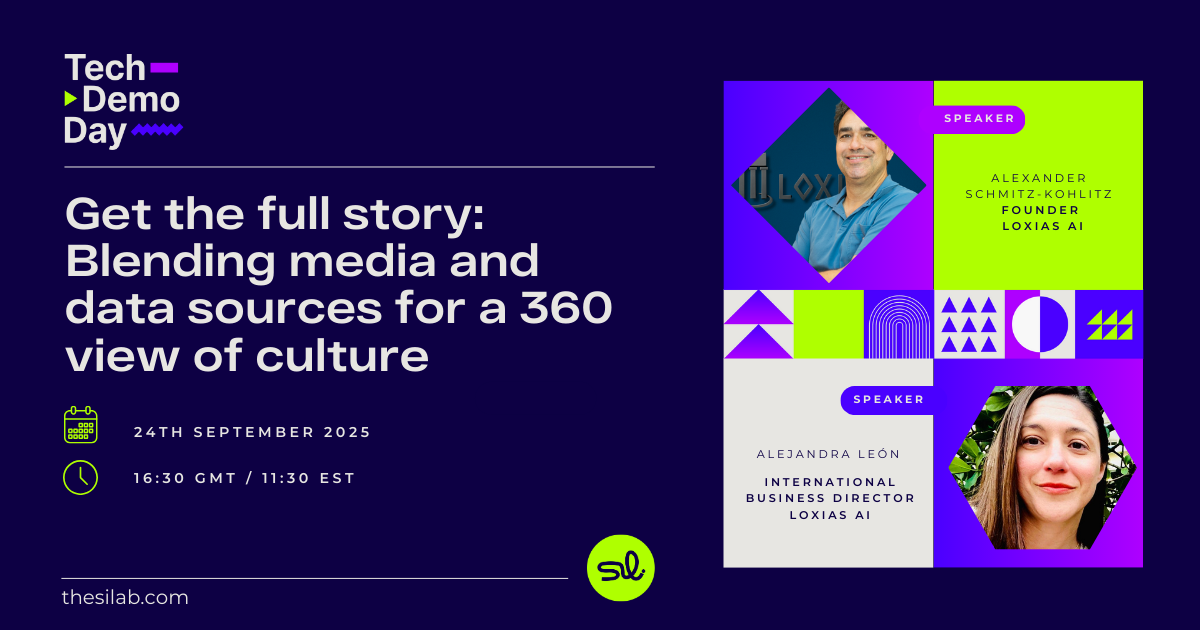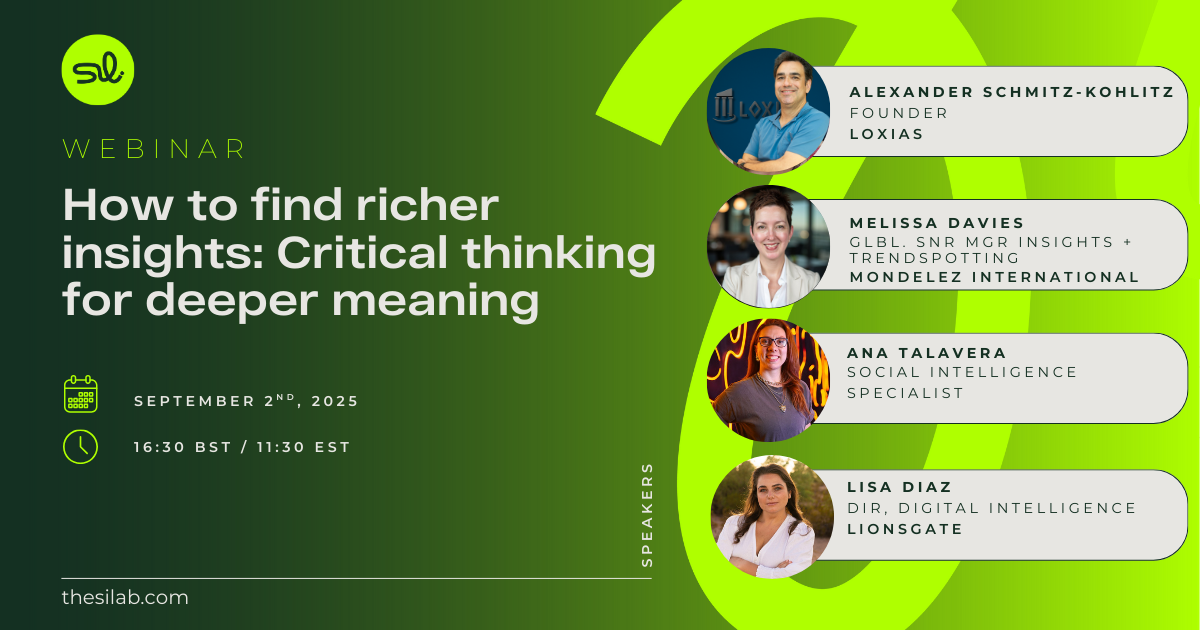.png)
How to use TikTok for social listening
TikTok. THE social media platform of the moment. Where Gen Z are most likely to be found, and which many think is the most authentic reflection of this demographic’s innermost thoughts. Its growth over the last few years has been exponential and it’s one of the most used social media apps around. And yet…it’s one of the hardest platforms for social intelligence professionals to use because of how difficult it is to access the data at scale. We saw this in the results of the 2025 State of Social Listening survey. It’s the data source that most people want to use but aren’t currently.
TikTok 101: What’s it all about?
TikTok is a short-form social video platform owned by the Chinese internet company ByteDance. In China, the app is known as Douyin. It was born out of a merger between Musical.ly - a social video platform based on lip-sync and comedy-based UGC - and TikTok, and launched in 2017. The original purpose of the platform has changed very little since.
From the start, the platform seemed designed for short attention spans, with the longest videos allowed being 15 seconds initially. This has since increased, but shorter videos tend to still perform better. And TikTok is well known for its “For You Page” (or FYP) algorithm that exposes people to new and popular content, beyond those they follow, to keep them scrolling.
While social intelligence professionals are keen to get access to TikTok data to better understand audiences, it’s only the fifth most popular social platform, with around 8% of adults identifying it as their favourite. However, the type of people it attracts is what makes it interesting. More on that later.
What’s the vibe?
Like Reddit, it’s considered one of the more authentic platforms. The place where users can be their true selves; they don’t feel the need to curate their feed, as they might on Instagram. In fact, for younger generations, the scrappier, the better. And the video format is what really appeals to GenZ and younger generations, who have grown up with it being an integral part of the internet.
Some of the most popular types of content include dance challenges, lip sync videos, music performances, comedy skits and educational clips. A key feature of content shared is replication. People will take a viral video and recreate it, putting their own unique spin on it.
TikTok has also been able to create a community vibe, perhaps more than other similar platforms, as users can find other people with similar interests more easily, thanks to the algorithm that continuously feeds new content based on their preferances. They don’t even have to look for it. This has led to the rise of well-known communities such as Booktok (for book- lovers), Planttok (for plant-lovers) and Moneytok (for those looking for financial advice). And the ability to create collaborative content with other users and comment and interact with others via their posts adds to this community feeling.
It’s for this reason that TikTok has become the go-to search engine for many - a study by Adobe in 2024 showed it to be the fourth most popular among digital natives, and 10% of Gen Z choose it over Google. If they want to know something, they trust their TikTok communities more than a commercial search engine.
What makes TikTok different from other social data sources?
As mentioned, what really helps TikTok stand out over other data sources is their algorithm. It’s unique compared to other social media platforms because of the factors it considers when making recommendations for everyone’s FYP. For example:
- What type of content users post comments on
- What videos users like
- Which videos are users sharing
- Which videos users said they're not interested in
- What kind of content is being hidden or reported
That’s what makes it so addictive.
It also offers a range of features for users to customise and enhance their own content - such as music, filters, effects, and editing tools - giving them the feeling that they’re creating something unique.
Another differentiating feature of TikTok is its success with social shopping. As early as 2019, it partnered with Shopify, allowing creators to embed merchandise sale links into their videos. TikTok Shop was beta-tested in the UK and Southeast Asia in November 2022 before being rolled out globally in September 2023. Soon after this, around US $7m worth of products were being sold daily. In the US in 2024, around 170m customers and around 7m businesses used TikTok for shopping and spent an estimated US $32m per day. The most popular sectors (almost 80% of sales) being health and beauty products.
Ultimately, TikTok has proven itself to be pretty much irreplaceable, since the threat of it being banned in the US earlier in 2025. After it was briefly taken off the app store in the US, the Reels app (Meta-owned TikTok alternative) saw a 21% increase in installs. However, in the 6-weeks after returning to the app store, installs of TikTok surged 82%.
Who uses TikTok?
You probably already have a good idea of TikTok’s main user base, but let’s dig into the numbers.
Since its international launch in 2017, the platform has seen rapid growth. Within four years, the platform had been downloaded more than 2bn times globally and had 800m monthly active users worldwide. By early 2025, it reached 1.8bn users. Between March and April 2025 alone there were 5m downloads worldwide.
TikTok’s largest user group is, unsurprisingly, Gen Z. For this group, the platform is more popular than Instagram, although not as popular as Snapchat. The average age of users is between 25 and 34, with men in this age range the biggest group globally (20.7% of total users).
And when people are using the app, they’re really using the app. It dominates in terms of user attention. In 2024, US TikTok users spent on average around 80 minutes per day, and the average time spent on the app globally (according to Android user data) is 58 minutes 24 seconds. This has more than doubled since 2019.
The platform is available worldwide, and as of January 2025, the countries with the most users were the US (136m active users), Indonesia (108m active users), Brazil (91.7m active users), Mexico (85.4m active users) and Pakistan (66.9m users).
But let’s address the elephant in the room. The US government is currently (May 2025) still to decide on a deal which will allow TikTok to continue operating in the country. As a result, a more long-term, even permanent, ban is possible.
TikTok is mostly used by individuals but, given their demographic, it’s an attractive place for brands to be too. The ones that do well are those who create specific content for TikTok, rather than just repurpose existing content from other platforms. That means it’s usually less refined, kookier and speaks to a younger audience. Good examples include Duolingo, Ryanair, Red Bull, Washington Post and RSPB. TikTok actively encourages businesses to use their platform and release an annual trend forecast, with advice on how brands can leverage them.
When it comes to bots, like most of the internet, they’re unavoidable. However, according to TikTok’s own data, they make up a small percentage of users. In Q4 2024, they removed over 30,000 accounts “associated with previously disrupted networks that had attempted to return” to the platform, and 157,158,547 comments from accounts that violated policies around fake content and engagement. Of the total removals in that period, 2.1% was for integrity and authenticity reaons, including misinformation (40.3%), civic and election integrity (34.6%), edited media and AI-generated content (17.4%), fake engagement (7%) and unoriginal content (0.8%).
The low volume of bots reported, suggests social intelligence professionals can use this data with a high level of confidence that they’re getting the authentic voice of the customer. Although, as with any internet data source, it’s always important to be aware of data quality.
How to access TikTok data for social listening
That is the big question. And a major challenge for social data analysts. Because there is currently no API for commercial data access.
The amount of TikTok data that can be fed to social listening tools for analysis is limited. For now, large volume data access is available for research purposes and restricted to academic/ research institutes and non-profits or charitable organisations. Tools like ViralMoment are able to leverage existing TikTok APIs to collect certain data beyond that coming through owned accounts.
TikTok also have several partnerships with social listening platforms but that focus only on four areas:
- Agency: For creating brand campaigns
- Creative: For making TikTok content
- Marketing technology: To launch, scale and optimise campaigns
- Measurement: to evaluate campaign performance and optimise in future
Some of these partners include Agora Pulse, Brandwatch, Emplifi, Hootsuite, Khoros, Meltwater, Sprinklr and Sprout Social.
There are also platforms that offer social listening for TikTok but only through owned TikTok Business accounts. For example, Talkwalker.
Some platforms offer much greater access to TikTok data, beyond that which is accessible via the current APIs and owned accounts. As there is no official API for large-scale data capture, it could be that these platforms are scraping the data from the platform. Whilst this isn’t illegal, it is a grey area and could create access problems in future, and potential legal challenges if TikTok decides to crack down on this type of activity. If a platform is offering access to more data than others, particularly than the mainstream providers, it’s worth asking how they’re doing this.
To analyse TikTok data more broadly, you can also do it the old-fashioned way. Find the community you want to learn more about, spend time following the hashtags and groups that they engage with, and manually go through the different posts and comments to understand the conversations that are happening there. It’s slow, and hard to scale, but can give some unique and helpful insights.
What are the main use cases that TikTok data can support?
TikTok data has the potential to support a lot of use cases…that’s probably another reason so many want to get their hands on it. They include:
- Ad & campaign performance
- Audience segmentation & discovery
- Brand health tracking
- Brand trust & credibility analysis
- Consumer advocacy & brand loyalty
- Consumer behaviour & decision-making
- Content performance & optimisation
- Competitive benchmarking
- Crisis detection & response
- Cultural & societal trend analysis
- Customer experience & satisfaction
- Employee sentiment & advocacy
- Event & sponsorship analysis
- Hashtag & UGC (user-generated content) performance
- Influencer impact & credibility
- Market & industry trends
- Misinformation & disinformation detection
- Online reputation management
- Opportunity identification (engagement/comms)
- Opportunity identification (Innovation/ product development)
- Product & service insights
- Viral trends detection & amplification
Already, we’ve seen some great examples of brands using TikTok for these use cases. It played a crucial role in Warner Bros’ tracking of the Barbie movie campaign performance. As ViralMoment explained, by using social video analysis, they could identify all UGC made around the film. Between April and July 2023, 31K pieces were generated, with around 66% posted in the month of July alone, linking to the film’s release. And tracking the hashtags, video transcriptions and conversations happening around the move enabled them an insight into communities such as Barbietok Fashiontok and Filmtok. From this they could measure the ripple effect the film had on other industries.
It’s also great for helping brands identify ways to engage with their customers through UGC trends and memes. When McDonald’s launched a special meal box with a purple shake in 2023 to celebrate the character Grimace’s birthday, it unleashed a massive viral moment. And not because of their own marketing. Instead, TikTok users began portraying Grimace as an evil character, showing potentially fatal consequences of drinking the shake. They challenged others to make similar videos…and that’s when it took off. By analysing TikTok data around their brand, ViralMoment shows that McDonald’s had the opportunity to benefit from early detection of the trend and optimised content around the theme to better target their audience.
Case study: Using TikTok for product development
TikTok is also a great data source for discovering things you might not have known about your customers. That makes it the perfect place to generate ideas for new products, which is how Nichefire worked with one of their clients recently. Here’s the full case study.
Can you give an example of when you’ve used TikTok on a particular social intelligence project?
“We worked with a leading beverage company that wanted to explore early-stage innovation ideas in the ready-to-drink (RTD) and iced coffee space. The goal was to scan emerging consumer conversations, especially on TikTok, to uncover culturally relevant product concepts that could feed into their long innovation and R&D cycles.”
Why did you choose TikTok for this particular project?
“TikTok was the ideal platform for this project because of its role in shaping consumer rituals and taste exploration, particularly among younger demographics. While many trends on the platform are short-lived, TikTok often acts as an early signal for shifts in behavior and preference that can be validated elsewhere. It served as a fast-moving source of inspiration to “boil the ocean” and surface potential innovation directions.”
How did you collect and sort the data?
“We used Nichefire to monitor beverage-related trends on TikTok, covering areas like “functional coffee,” “hydration hacks,” “collagen creamers,” and “natural energy boosters.” The platform automatically ingested, filtered, and categorized TikTok content by engagement, relevance, and thematic fit. Trends were then scored for cultural stickiness and flagged for review.”
What approach did you take to analyze the data?
“Our approach combined real-time signal detection with predictive analysis. We looked at velocity and sentiment on TikTok, but also assessed which trends showed signs of lasting relevance through cross-platform validation (e.g., Reddit, forums, search data). Ideas with consistent cultural relevance were prioritized for internal innovation teams.”
Did you blend TikTok data with any other data sources?
“Yes. TikTok insights were triangulated with other social sources, like Reddit, Bluesky, and X, and Google search traffic to evaluate real-world traction. This multi-source approach helped ensure that the trends we recommended had both buzz and staying power.”
Is there anything in this project that TikTok data wasn’t useful for?
“TikTok wasn’t as effective for measuring commercial adoption or regional nuance. For example, it didn’t reveal whether a trend had penetrated foodservice channels or retail shelves, insights that were pulled from other sources like menus and product listings.”
So, let’s go deeper into this elusive platform to learn why it’s so interesting for social intelligence professionals, and how we can use it, even with the limitations that currently exist.
“We regularly use TikTok to seed innovation pipelines, inspire content strategy, and monitor cultural rituals around product usage. It’s especially powerful for identifying white-space opportunities early, before they show up in more traditional data sources.”
What’s next for TikTok?
The main event for TikTok in the short-term is the decision from the US government about whether the app will be banned if it’s not sold to an American company. Despite ByteDance’s initial refusal to sell the app, there have been discussions around deals more recently. Nothing has been confirmed yet, which creates a lot of uncertainty in the US market. For social intelligence professionals whose customers are largely US-based, a ban would make TikTok a less useful data source. And we’ve already seen many analysts in this year’s State of Social Listening survey look at ways to access the TikTok alternatives that consumers are turning to, such as Rednote.
Stay tuned for more
TikTok is volatile in format, access, and possibly legality. But right now, it’s one of the richest sources of cultural signal available. If you care about meaning, you can’t ignore it.
You should now have a better idea of how to use TikTok data for social listening, the use cases that it can support and the challenges you’re likely to face trying to use it at scale. As with the other posts in this series, this is a work in progress. Given how fast the internet changes, this article is probably already out of date by the time you’re reading it! So, if you spot anything that’s changed or hasn’t been included, feel free to let us know and we’ll fix it in the next edit.
And to make sure you receive content like this straight to your inbox as soon as it’s available, make sure to subscribe to our newsletter.
This interview was recorded via LinkedIn Live, if you prefer to view on LinkedIn, click the button below.
View InterviewSee related content
.png)








.jpeg)


